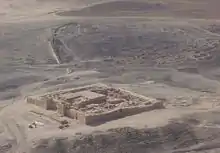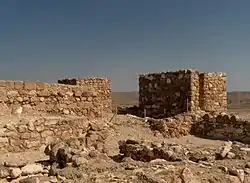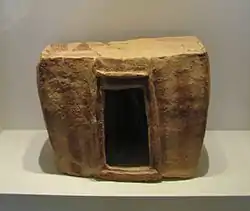Tel Arad
Tel Arad (Arabic: تل عراد, Hebrew: תל ערד) is an archaeological tel, or mound, located west of the Dead Sea, about 10 kilometres (6 miles) west of the modern Israeli city of Arad in an area surrounded by mountain ridges which is known as the Arad Plain. The site is divided into a lower city and an upper hill. It was first identified in modern literature in 1841 by Edward Robinson in his Biblical Researches in Palestine, on account of the similarity of the Arabic place name with the Harad in the Book of Joshua.[1][2] Tel Arad was excavated during 18 seasons by Ruth Amiran and Yohanan Aharoni.
תל ערד | |
 Aerial View of upper Tel Arad | |
 Shown within Israel | |
| Location | |
|---|---|
| Region | Negev |
| Coordinates | 31.280833°N 35.125°E |
| Site notes | |
| Archaeologists | Yohanan Aharoni, Ruth Amiran |
| Public access | National Park |
Over 100 ostraca (inscribed pottery shards) written in Hebrew, dated to about 600 BCE were found during the excavation of the fort at Arad.[3] Most of these consist of everyday military correspondence between the commanders of the fort and are addressed to Eliashib, thought to be the fort's quartermaster.[4] One ostracon mentions "house of YHWH" which some scholars believe is a reference to the Jerusalem temple.[5] That would make the ostracon only existing extra-biblical reference to the temple in Jerusalem.
History and archaeology

Chalcolithic
The lower area was first settled during the Chalcolithic period, around 4000 BCE.
Early Bronze
In the Early Bronze, Tel Arad was occupied in the Early Bronze I-II and part of the Beersheba Valley copper trade. It was abandoned in the EB III with the rise of central trading sites in the Negev Highlands related to the copper industry in the Arabah and trade towards Egypt in the Old Kingdom.[6]
The Early Bronze I saw Tel Arad Stratum III.
The Early Bronze II saw rich remains at Tel Arad Stratum II.[7]
Iron Age
The site was only resettled by Israelites from the 11th century BCE onwards,[8] initially as an unwalled area defined as an official or sacred domain was established on the upper hill, and then later as a garrison-town or citadel.
The citadel and sanctuary were constructed at the time associated in the biblical narrative with King David and Solomon. Artifacts found within the sanctuary of the citadel mostly reflect offerings of oil, wine, wheat, etc. brought there by numerous people throughout the reign of the kings of Judah until the kingdom's fall to the Babylonians. However, during the Persian, Maccabean, Roman, and Early Muslim periods, locals continued to bring these items to the sacred precinct of the upper hill. Markers of these ancient Israelite rituals remain to this day, with broken pottery littering the entire site.
Under the Judaean kings, the citadel was periodically refortified, remodelled and rebuilt, until being ultimately destroyed between 597-577 BCE, whilst Jerusalem was under siege by Babylonian king Nebuchadnezzar II.
Hellenistic and Roman periods
It is believed that several citadels were built one upon the other and existed in the Hellenistic and Roman periods.
Herod even reconstructed the lower city for the purpose of making bread. The site lasted until the Romans destroyed Jerusalem and completely expelled the Jews in 135 AD.
Muslim conquest to Abbasid period
Tel Arad lay in ruins for 500 years until the Early Islamic period, when the former Roman citadel was rebuilt and remodeled by some prosperous clan in the area and functioned for 200 years until around 861 AD, when there was a breakdown of central authority and a period of widespread rebellion and unrest. The citadel was destroyed and no more structures were built on the site.
Sanctuary at Arad
.JPG.webp)

The temple at Arad was uncovered by archaeologist Yohanan Aharoni in 1962 who spent the rest of his life considering its mysteries, dying there in the mid-1970s.
In the holy of holies of this temple two incense altars and a standing stone were found, probably having been dedicated to Yahweh. Unidentified dark material preserved on their upper surfaces was submitted for organic residue analysis and traces of cannabinoids, boswellic acid, and norursatriene (which derives from frankincense) were detected. While the use of frankincense for cultic purposes is well-known, this finding is of especial importance insofar as it represents the "first known evidence of hallucinogenic substance found in the Kingdom of Judah."[9]
The lower settlement and the upper Israelite citadel are now part of the Tel Arad National Park which have begun projects to restore the walls of the upper and lower sites.
See also
References
- Edward Robinson; Eli Smith (1841). Biblical Researches in Palestine. Crocker & Brewster. pp. 473–. See also Tell Arad in Robinson’s name list
- Charles William Meredith van de Velde (1854). Narrative of a Journey Through Syria and Palestine in 1851 and 1852. W. Blackwood and sons. pp. 84–.
- Pike 2020, p. 203.
- Kershner 2017.
- Pike 2020, p. 205; King & Stager 2001, p. 314; Dever 2001, p. 212
- Israel Finkelstein, Matthew J. Adams, Zachary C. Dunseth & Ruth Shahack-Gross (2018) The Archaeology and History of the Negev and Neighbouring Areas in the Third Millennium BCE: A New Paradigm, Tel Aviv, 45:1, 63-88, DOI: 10.1080/03344355.2018.1412054
- Johanna Regev, Sarit Paz, Raphael Greenberg, Elisabetta Boaretto. (2019) Radiocarbon chronology of the EB I–II and II–III transitions at Tel Bet Yerah, and its implications for the nature of social change in the southern Levant. Levant 51:1, pages 54-75. Israel Finkelstein, Matthew J. Adams, Zachary C. Dunseth, Ruth Shahack-Gross. (2018) The Archaeology and History of the Negev and Neighbouring Areas in the Third Millennium BCE: A New Paradigm. Tel Aviv 45:1, pages 63-88.
- "The Israelite Fortress at Arad". Bulletin of the American Schools of Oriental Research (254, Spring 1984): 1–34.
- Arie, Eran; Rosen, Baruch; Namdar, Dvory (28 May 2020). "Cannabis and Frankincense at the Judahite Shrine of Arad". Journal of the Institute of Archaeology of Tel Aviv University. Cite journal requires
|journal=(help)
Sources
- Pike, Dana M. (February 4, 2020). "Israelite Inscriptions from the Time of Jeremiah and Lehi". BYU ScholarsArchive. Retrieved December 2, 2020.
- Kershner, Isabel (April 11, 2016). "New Evidence on When Bible Was Written: Ancient Shopping Lists". The New York Times. Retrieved December 9, 2020.
- King, Philip J. (April 15, 1993). Jeremiah: An Archaeological Companion. Westminster John Knox Press. pp. 57–. ISBN 978-0-664-22443-1.
- Dever, William G. (May 10, 2001). What Did the Biblical Writers Know and When Did They Know It?: What Archeology Can Tell Us About the Reality of Ancient Israel. Wm. B. Eerdmans Publishing. ISBN 978-0-8028-2126-3.
